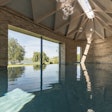
This time around, the discussion crossed my path again last week when I received an email from my good friend, pool designer and builder, Bill Drakeley, (Drakeley Swimming Pool Company, Bethlehem, Conn.) In his note, Bill offered kind comments about my contribution to AQUA and had particular praise for a project featured in the January edition of AQUA Architecture by our mutual friend Randy Beard (Pure Water Pools, Newport Beach, Calif.). In the article Randy covered a massive remodeling project that featured a dazzling tile mosaic finish and among other things, his belief in, and use of, waterproofing agents.
Bill offered his compliments and then made a fundamental point about quality construction. He writes: “My thought is for my friend, Randy. His article is awesome and the pool is killer. However, the ‘magic pill’ for waterproofing still starts with quality concrete application and not some band-aid. Waterproofing is a brand new idea considering how long people have been building watershapes. In my not so humble opinion, consistency in durable building is the only problem. If quality and education were consistent with basic guides, waterproofing (technically damp proofing) would be non-existent.”
Bill’s opinion is backed up by experience: He has been approved by the American Concrete Institute (ACI) as a Certified Examiner for the Shotcrete process and as a Certified Nozzleman regarding the shotcrete process. Not surprising he’s been a consistent advocate of quality construction techniques for years now and is among those who believe that waterproofing agents would not be necessary if proper construction techniques were always followed to a tee.
Randy, who himself enjoys a variety of industry honorifics for design and construction, also believes in quality construction, but then also uses waterproofing agents as part of his program. As Randy describes in the articles he uses a variety of products based on very specific circumstances and conditions, all as a way to ensure his pools do not leak. For Bill’s part, he contends that if, among other things, you hit certain levels of compression strength of concrete, pool structures in effect become functionally watertight.
Considering the work of these two professionals and the divide on the issue of waterproofing, I personally find myself agreeing with both, even though they don’t entirely agree with each other. Yes, quality construction is the foundation of professional work. And, yes, using waterproofing agents on concrete structures that contain water is not a bad idea.
Back in August, I offered my own thoughts on compression strength and received a particularly long list of thoughtful responses. One came from Genesis 3 co-founder, Skip Phillips (Questar Pools, Excondido, Calif.) who wrote, “It is difficult to understand how there could be a reasonable debate on whether to meet the A.C.I. nationally accepted 4,000 psi concrete compression minimum.”
In that set of exchanges, Bill Drakeley added, “If the process is implemented correctly, specifically with binder (Portland) covering 100 percent surface are of each aggregate particle (from sand fines up to stone) and the velocity is correct in terms of FPS along with correct application techniques -- 4000 psi is the least you can get. ACI 506 test averages (regardless of industry) are between 4500 and 9000 psi. Anything less than that is an indication of a shortcoming in your process. Unfortunately, parts of the pool industry have accepted these low values as standard or acceptable.”
It seems fairly obvious that you can make an extremely strong case for the 4,000 p.s.i. standard, but where does that leave us with the question of waterproofing? Can waterproofing be left out of the mix when recommended compression strengths are met, or should we assume that all concrete to some degree is susceptible to moisture intrusion and waterproofing is helpful?












































